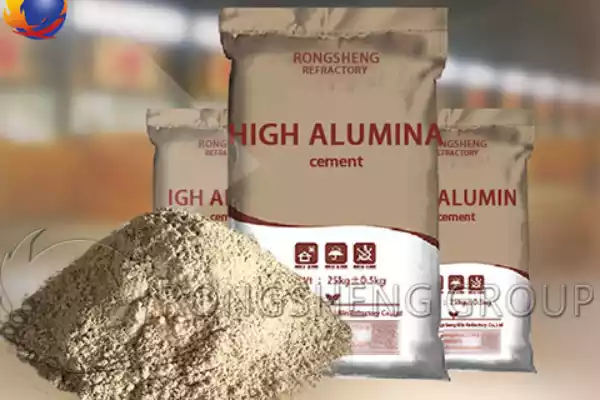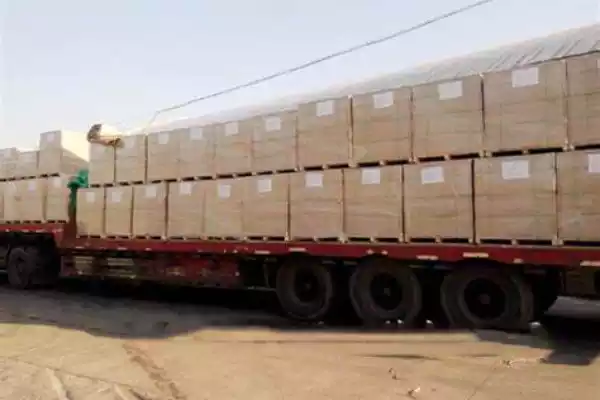O que é cimento refratário?
Refractory cement is also called aluminate cement and high-temperature cement. Aluminate cement is made of bauxite and limestone as raw materials, calcined clinker with calcium aluminate as the main component, and alumina content of about 50%, and then ground into a hydraulic cementitious material, refractory cement often yellow or brown, but also gray. High-temperature-resistant cement is usually used for lining industrial kilns.

Classification of refractory cement
O cimento refratário pode ser dividido em cimento refratário de aluminato, cimento refratário com baixo teor de aluminato de cálcio, cimento de aluminato de cálcio e magnésio, and dolomite refractory cement according to the different components.
1. Cimento refratário de aluminato
Aluminate refractory cement is generally a refractory cement made by mixing and grinding low-calcium aluminate refractory cement clinker and high-alumina cement clinker. Compared with low-calcium aluminate refractory cement: higher early strength, similar refractoriness, and consistent use.
2. Cimento refratário com baixo teor de aluminato de cálcio
Low-calcium aluminate refractory cement is made of high-quality bauxite and limestone in an appropriate proportion, sinterizado e retificado.
3. Cimento de aluminato de cálcio e magnésio
Calcium-magnesium-aluminate cement is mainly made of high-quality bauxite and dolomite in an appropriate proportion, sinterizado e retificado. The composition of calcium magnesium aluminate cement is usually: alumina é responsável por 66% para 74%, o óxido de cálcio é responsável 13% para 18%, e o óxido de magnésio é responsável 10% para 13%. Silica and iron oxide traces. The mineral composition is calcium aluminate and calcium aluminate accounts for 45% para 60%, and spinel accounts for 35% para 50%. The refractoriness is above 1650°C.
3. Dolomite refractory cement
Dolomite high-temperature cement is made of dolomite as the main raw material and then added with apatite, minério de ferro, etc.
What are the technical requirements for the production of high-temperature cement?
- The fineness of high-temperature cement: The finer the cement particles, the larger the specific surface area, the faster and more sufficient the hydration reaction, and the higher the early and later strength.
- Setting time of high-temperature cement: To ensure that there is sufficient time to complete various processes such as mixing, transporte, and molding during construction, the initial setting time of cement should not be too short; after the construction is completed, it is hoped that the cement can harden as soon as possible to generate strength, so the final setting time should not be too long. The initial setting time of fire cement resistance should not be earlier than 45 minutos, and the final setting time should not be later than 390 minutos.
- Volume stability of refractory cement: The uniformity of volume change of cement paste in the process of setting and hardening is called the volume stability of cement. If the volume change is uneven, the volume stability is poor, and warping and cracking are prone to occur, reducing the quality of the project and even causing accidents.
What problems should be paid attention to when baking refractory cement furnace lining?
- At room temperature of 350°C, it is most likely to cause local bursts, portanto, atenção especial deve ser dada ao cozimento lento. If there is still a lot of steam coming out after keeping warm at 350°C, a taxa de aquecimento ainda deve ser retardada.
- Under the conditions of poor ventilation and difficult discharge of water vapor, the holding time should be extended appropriately.
- Ao assar com óleo pesado, it is necessary to strictly prevent the heavy oil from spraying on the surface of the furnace lining to prevent partial bursting.
- Ao assar com lenha, direct contact with the flame often causes local heating to be too rapid, so it should be protected.
- For the newly poured fire cement resistant, it can be baked after at least 3 dias.
- The cooling of the refractory cement lining should also be slow, and forced ventilation should be avoided.
Rongsheng monolithic refractories factory


Rongsheng monolithic refractory material factory is a company that produces refractory materials for kilns. The monolithic refractory produced include moldáveis, low-cement castables, materiais de compactação, and plastics. We support refractory product customization and can send samples for free.
 Fábrica de Refratários Rongsheng
Fábrica de Refratários Rongsheng
WeChat
Escaneie o código QR com o wechat